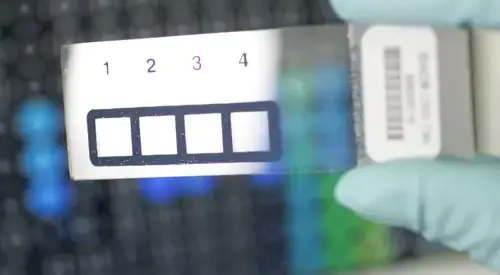Allergic rhinitis
"La Clínica has been the first Spanish center to incorporate the microarray technique as an aid to diagnosis, which accurately reveals the patient's level of awareness".
DR. GABRIEL GASTAMINZA LASARTE
DIRECTOR. ALLERGY AND IMMUNOLOGY DEPARTMENT

What is allergic rhinitis?
Allergic rhinitis is a disease caused by inflammation of the nasal mucosa caused by a reaction of the immune system to allergenic substances in the environment. Its symptoms resemble those of a common cold: nasal itching, sneezing, watery mucus and nasal congestion.
Although they may initially seem mild, these symptoms, if persistent, can considerably affect the quality of life. It is often accompanied by conjunctivitis and is frequently associated with the development of bronchial asthma.
The Clínica Universidad de Navarra was a pioneer in Spain in incorporating the use of microarrays for molecular diagnosis, an advanced precision diagnostic technique that makes it possible to identify sensitization to multiple allergens in a single analysis and thus establish a more adequate profile of the patient's pathology.

What are the symptoms of allergic rhinitis?
The most common symptoms are:
- Itchy nose.
- Watery nasal discharge.
- Frequent sneezing.
- Nasal congestion.
Unlike a cold, these symptoms are usually seasonal or in response to a specific allergen, are not accompanied by fever or general malaise, and disappear when contact with the allergen is avoided. For example, a person allergic to dust mites may experience symptoms when opening old books or shaking mattresses, which disappear when going outdoors.
Do you have any of these symptoms?
You may have allergic rhinitis
What are the causes of allergic rhinitis?
In most cases, allergic rhinitis is caused by the inhalation of environmental allergens such as:
- Dust mites
- Pollens
- Fungi
- Animal epithelia
- Substances present in the work environment
It can manifest seasonally (e.g., due to pollen exposure) or perennially (e.g., year-round due to household allergens such as animal epithelia). Some adults present typical rhinitis symptoms without sensitization to any known allergen, in which case the differential diagnosis is very varied (vasomotor rhinitis, local allergic rhinitis, infectious rhinitis, hormonal, medicinal, occupational, non-allergic eosinophilic rhinitis...) with similar symptoms, but different pathophysiological mechanisms and treatments.

How is allergic rhinitis diagnosed?

Diagnosis is usually made by skin tests (prick tests), in which small amounts of allergens are applied to the skin to observe the local reaction.
Blood tests can also be performed to quantify specific antibodies against certain allergens.
A complementary tool, available at the Clinica, is molecular diagnosis using microarrays, which provides precise information on sensitization to specific proteins present in foods, pollens, mites, shellfish, birds, among others. This technique allows a detailed evaluation without the need to expose the patient to multiple skin tests.
How is allergic rhinitis treated?
Comprehensive treatment for allergic rhinitis is based on:
- Allergen avoidance
Patient education is essential to minimize exposure and symptoms. - Pharmacological treatment
Includes antihistamines and/or nasal corticosteroids depending on the case. - Specific immunotherapy (vaccines)
It is the only curative treatment since it can induce tolerance to the allergen. It consists of periodically administering extracts of the allergen for 3 to 5 years to progressively reduce the patient's sensitivity, increase tolerance and reduce or cure symptoms in the long term. It can be administered subcutaneously (injectable) or sublingually (drops or tablets under the tongue). It should always be indicated by an allergist after an appropriate evaluation.
Where do we treat it?
IN NAVARRA AND MADRID
Department of Allergology
of the Clínica Universidad de Navarra
The Department of Allergy and Immunology of the Clinic is part of the Global Allergy and Asthma European Network, composed of the 25 best departments of Allergy in Europe, chosen for their scientific excellence, multidisciplinary work, teaching and international activities.
We have the most advanced diagnostic techniques, we are at the forefront of research and we collaborate with the best experts. We have more than 50 years of experience in the field.
What diseases do we treat?

Why at the Clinica?
- More than 50 years of experience.
- Pioneers in the technique of molecular diagnosis by microarray.
- Nursing specialized in allergic diseases and their care.








